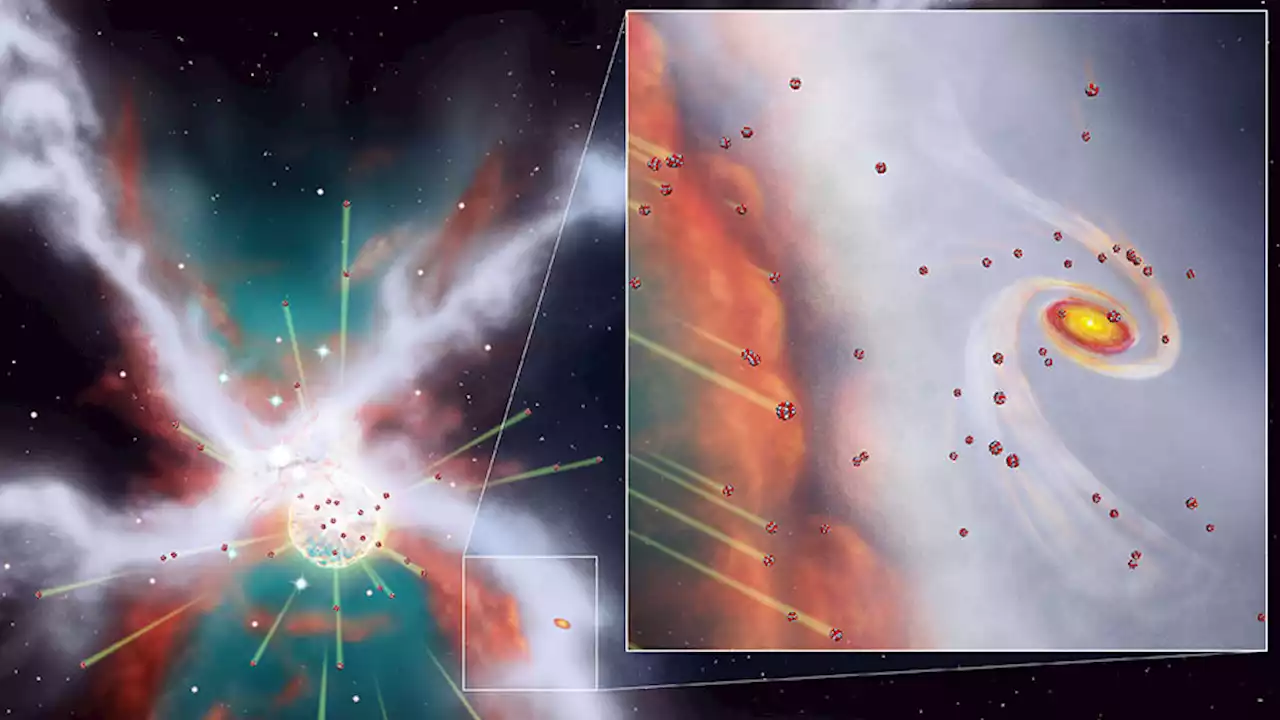Astronomers observed Supernova 2004et and Supernova 2017eaw using Webb’s MIRI instrument (Mid-Infrared Instrument).
's imaging wavelengths allow it to peer into stellar dust clouds, revealing intimate cosmic phenomena such as star formation.
Over 5,000 Earth masses of dust were estimated to be in SN 2004et. As a result, it has the "highest dust mass" ever detected in a supernova. “When you look at the calculation of how much dust we’re seeing in SN 2004et especially, it rivals the measurements in SN 1987A [supernova], and it’s only a fraction of the age. It’s the highest dust mass detected in supernovae since SN 1987A,” said Ori Fox of the Space Telescope Science Institute.
日本 最新ニュース, 日本 見出し
Similar News:他のニュース ソースから収集した、これに似たニュース記事を読むこともできます。
 Webb Telescope Spots Potential Fuel for Early Universe in Supernovae DebrisDust reservoirs spewed by two stellar deaths show how stars might be born.
Webb Telescope Spots Potential Fuel for Early Universe in Supernovae DebrisDust reservoirs spewed by two stellar deaths show how stars might be born.
続きを読む »
 Chicago man convicted of fraudulently obtaining $2.7M in COVID-19 relief fundsA Chicago man has been found guilty of wire fraud for his involvement in a scheme to defraud a government program during the coronavirus pandemic.
Chicago man convicted of fraudulently obtaining $2.7M in COVID-19 relief fundsA Chicago man has been found guilty of wire fraud for his involvement in a scheme to defraud a government program during the coronavirus pandemic.
続きを読む »
 A supernova may have come very close to destroying the early solar systemA new paper suggests the early solar system was shielded from the destructive force of an explosion caused by a dying star.
A supernova may have come very close to destroying the early solar systemA new paper suggests the early solar system was shielded from the destructive force of an explosion caused by a dying star.
続きを読む »
 The Early Universe Ran in Slow MotionOne of Einstein's predictions is that we should see time moving at different rates at different ages of the Universe. Researchers have confirmed this prediction out to half the age of the Universe using Type 1a supernovae as standard candles. Astronomers have gone much further back in time, observing quasars that sent out their light 12 billion years ago. Over this vast distance, time has slowed to a crawl, with every second experienced by those quasars taking five seconds from our perspective.
The Early Universe Ran in Slow MotionOne of Einstein's predictions is that we should see time moving at different rates at different ages of the Universe. Researchers have confirmed this prediction out to half the age of the Universe using Type 1a supernovae as standard candles. Astronomers have gone much further back in time, observing quasars that sent out their light 12 billion years ago. Over this vast distance, time has slowed to a crawl, with every second experienced by those quasars taking five seconds from our perspective.
続きを読む »
 TOI-2084 b and TOI-4184 b: two new sub-Neptunes around M dwarf starsWe present the discovery and validation of two TESS exoplanets orbiting nearby M dwarfs: TOI-2084b, and TOI-4184b. We characterized the host stars by combining spectra from Shane/Kast and Magellan/FIRE, SED (Spectral Energy Distribution) analysis, and stellar evolutionary models. In addition, we used Gemini-South/Zorro & -North/Alopeke high-resolution imaging, archival science images, and statistical validation packages to support the planetary interpretation. We performed a global analysis of multi-colour photometric data from TESS and ground-based facilities in order to derive the stellar and planetary physical parameters for each system. We find that TOI-2084b and TOI-4184b are sub-Neptune-sized planets with radii of Rp=2.47 +/- 0.13R_Earth and Rp=2.43 +/- 0.21R_Earth, respectively. TOI-2084b completes an orbit around its host star every 6.08 days, has an equilibrium temperature of T_eq= 527 +/- 8K and an irradiation of S_p=12.8 +/- 0.8 S_Earth. Its host star is a dwarf of spectral M2.0 +/- 0.5 at a distance of 114pc with an effective temperature of T_eff=3550 +/- 50 K, and has a wide, co-moving M8 companion at a projected separation of 1400 au. TOI-4184b orbits around an M5.0 +/- 0.5 type dwarf star (Kmag=11.87) each 4.9 days, and has an equilibrium temperature of T_eq=412 +/- 8 K and an irradiation of S_p=4.8 +/- 0.4 S_Earth. TOI-4184 is a metal poor star ([Fe/H]=-0.27 +/- 0.09 dex) at a distance of 69 pc with an effective temperature of T_eff=3225 +/- 75 K. Both planets are located at the edge of the sub-Jovian desert in the radius-period plane. The combination of the small size and the large infrared brightness of their host stars make these new planets promising targets for future atmospheric exploration with JWST.
TOI-2084 b and TOI-4184 b: two new sub-Neptunes around M dwarf starsWe present the discovery and validation of two TESS exoplanets orbiting nearby M dwarfs: TOI-2084b, and TOI-4184b. We characterized the host stars by combining spectra from Shane/Kast and Magellan/FIRE, SED (Spectral Energy Distribution) analysis, and stellar evolutionary models. In addition, we used Gemini-South/Zorro & -North/Alopeke high-resolution imaging, archival science images, and statistical validation packages to support the planetary interpretation. We performed a global analysis of multi-colour photometric data from TESS and ground-based facilities in order to derive the stellar and planetary physical parameters for each system. We find that TOI-2084b and TOI-4184b are sub-Neptune-sized planets with radii of Rp=2.47 +/- 0.13R_Earth and Rp=2.43 +/- 0.21R_Earth, respectively. TOI-2084b completes an orbit around its host star every 6.08 days, has an equilibrium temperature of T_eq= 527 +/- 8K and an irradiation of S_p=12.8 +/- 0.8 S_Earth. Its host star is a dwarf of spectral M2.0 +/- 0.5 at a distance of 114pc with an effective temperature of T_eff=3550 +/- 50 K, and has a wide, co-moving M8 companion at a projected separation of 1400 au. TOI-4184b orbits around an M5.0 +/- 0.5 type dwarf star (Kmag=11.87) each 4.9 days, and has an equilibrium temperature of T_eq=412 +/- 8 K and an irradiation of S_p=4.8 +/- 0.4 S_Earth. TOI-4184 is a metal poor star ([Fe/H]=-0.27 +/- 0.09 dex) at a distance of 69 pc with an effective temperature of T_eff=3225 +/- 75 K. Both planets are located at the edge of the sub-Jovian desert in the radius-period plane. The combination of the small size and the large infrared brightness of their host stars make these new planets promising targets for future atmospheric exploration with JWST.
続きを読む »
 Al Roker is a grandpa! TODAY co-host's daughter welcomes first childAl’s daughter Courtney gave birth to a baby girl named Sky Clara Laga.
Al Roker is a grandpa! TODAY co-host's daughter welcomes first childAl’s daughter Courtney gave birth to a baby girl named Sky Clara Laga.
続きを読む »
